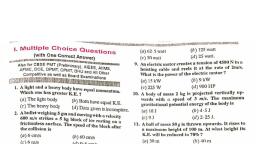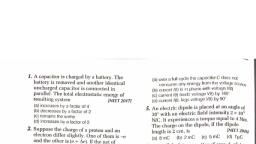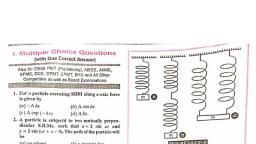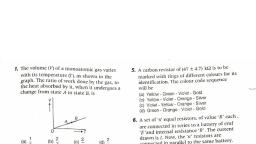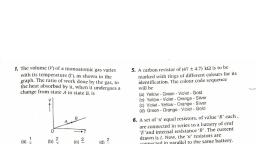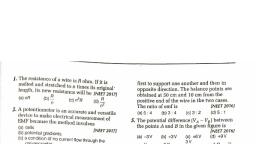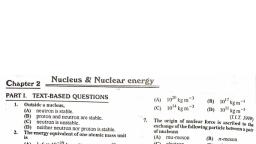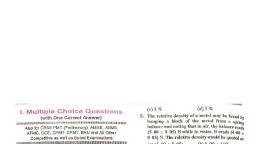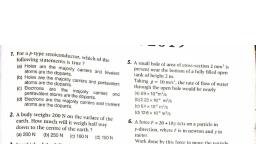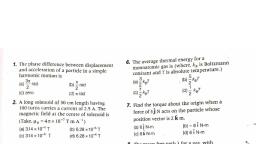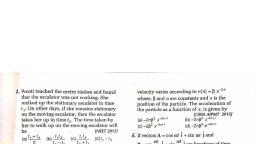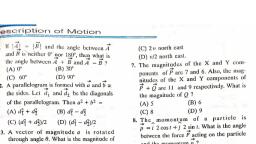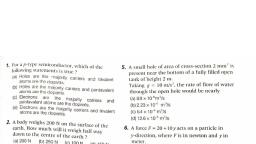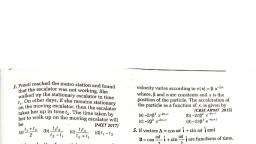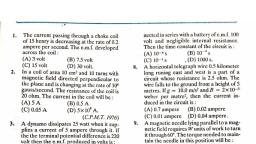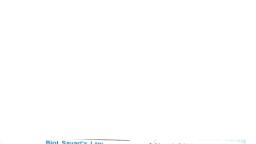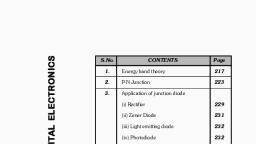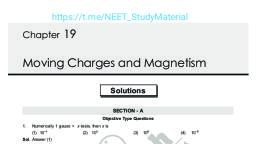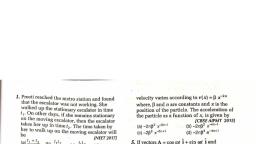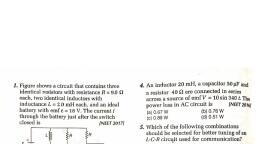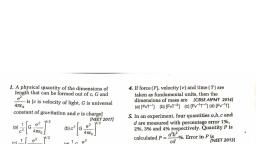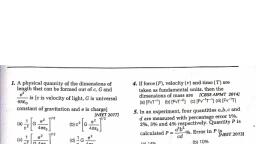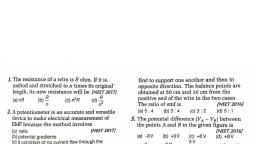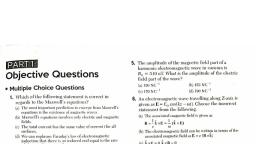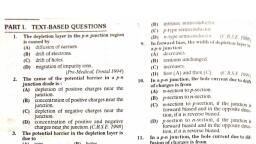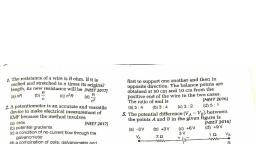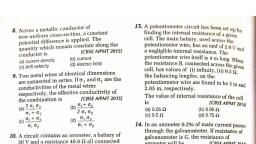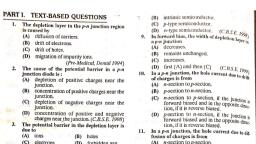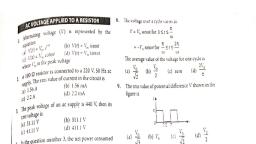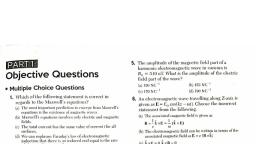Page 1 :
1, , |, TEXT-BASED QUESTIONS, , ue ‘Anormal domestic electric supply is an alter, nating current, whose average value is, (Al zero., (B) half the peak value., , (©) the peak value multiplied by 5., , (D) the peak value divided by 5., , (Karnataka Entrance, 1992), The mean value of a.c. is related to peak value, ofa.c. by the equation, , (A) Ie = ¥2 Io (B) b=y21,, © =22 om a2, , ‘The t.m.s. value of a.c. is related to peak value, of a.c. by the equation, , (A) Time =V2 10 (B) lo = V2 Teme,, , (Cc) lens = 8 (D) Uo = A tema, , The equation of an a.c. voltage is, V=200 sin SOx 4., Then, the rams. value of voltage is, (A) 100V2 Vv (B) 200V2V, (Cc) 100V (D) 400V, (Pre-degree Kerala, 1989), An electric lamp is connected to 220 V, 50 Hz, supply. The peak voltage in the circuit is, (A) 110V (B) 220V, (Cc) 311V (D) 320V, (A.M.C. 1996), An electric bulb rated 220 V is connected to, 220 V, 5 Hz source. Then, the bulb, (A) docs not glow., (B) glows intermittently., (C) glows continuously,, (D) | fuses,, An inductor, (A) allows a.c. to pass but blocks d.c., (B) allows d.c. to pass but blocks a.c.
Page 2 :
il., , (C) allows both a.c. and d.c. to pass., (D) blocks d.c., In an acc, circuit containing inductance,, , (A) current lags the voltage by 90°., (B) current lags the voltage by 180°., (C) current leads the voltage by 90°., , (D) none of the above., (Karnataka Entrance, i984), , ‘The inductive reactance of an inductance of, , 2 tat soz is, , (A) 1002 a) 2a, , (C) 2 (D) 50x2, ‘An alternating e.m.f. is applied to a pure induc, tance, such that inductive reactance is 10 2.1, the frequency of a.c. is doubled, the reactance, , will become, (A) SQ (B) WQ, (c) 152 (D) 202, , When a.c. flows through # capacitor, then the, current, , (A) leads e.m.f. by., , (B) lags e.m.f by =., , (C) isin phase with e.m-f., (D) none of the above., , 12. Acapacitor, , 13., , (A) offers easy path to a.c. but blocks d.c., , (B) offers easy path to d.c. but blocks a.c., , (C) offers easy path to both a.c. and d.c,, , (D) blocks a.c., , The capacitive reactance of a capacitor of, , 2 ea, Tq Patio His, , (A) xx 102, (C) 221x102 = (D), , (B) xx 102, 1072, , 4. An alternating e.1.f. is applied to a pure, , capacitance, such that the capacitive reactance, is 10 Q. If the frequency of u.c. is doubled, the, reactance will become, (A) 52, (Cc) 152, , (B) 102, (D) 202, , 5. An a.c. voltage source E = 200 v2 sin 100¢ is, , connected across a circuit containing an a.c., ammeter and a capacitor of capacitance 1 #F., , The reading of ammeter is, (A) 10mA (B) 20mA, (C) 40mA (D) 80mA, , (C.P.M.T, 1991 ; N.CERT, 1984), , \6. In an a.c. circuit, the current, , (A) _ is abways in phase with, (B) always leads the emf. =, (C) always lags the emf., , (D) any of the above, depending upon the ele, ments (L, Cor R) of the, , 17., , 1., , 21., , 22., , 23., , 24., , A 220 V, SO Hz ac. 7, inductance of 0-2 heuy mad’, connected y, ohn in series. What is the current in Preieed 4y,, (A) 1A (by SA clreuigy, , (C) 33-34 (D) 3-334, (Karnataka EF;, , In an LCR-series a,c. cireuit, Gecene ”, (A) _ is always in phase with the Voltage ', (B) always lags the generator voltage, (C) always leads the generator Voltage, (D) may lag behind or lead the voltage,, , . (CET. 1998; py 1. In, ‘Vhe impedance of an a.c. (LCR ith j, z ) circuit is tiven, , (ay YR? = (Xe +X?, (By) VR? + (Xe - X1)?, , (Cc) VR?=(Xc- XP, , my VR? +4 (Xe+ XP?, , (Karnataka Entrance, For the current in LCR-circuit to be “aed, , (A) w=LC 2.1, (B) w tt, , (C) o=re (D) w=Lec, , A 1 mil inductance and 10 pF ca, when connected in series to wae eae, sess equal reactance. The angular fr, the a.c. source is . ee, (A) 10°, , (c) 10, , (B) 100, (D) 2002, , In Q. 21, the value of the reactance of either, them is, , (A) 0°12 (B) 0-012, , (C) 0-22Q (D) 10Q, , An uc. circuit using an inductor ands, capacitor in series has a maximum curreat, L = 0-5 Hand C = 82F, then the angele, , frequency of a,c. voltage will be, , (A) 500 (By 5x10, , (Cc) 4000 (D) 5000 ;, (CEM., , In an LCR-circuit, the capacitance is, , nan circuit, the capa —, , from C to 4.C. For the same resonan! 1, cy, the inductance should be changed fro#, , to, (By) 12, , (A) 2L, (c) 4L a, , An LCR-circuit is connected to # 4 wo, current under resonant condition © js, difference between the applied ¥ tage, current in the circuit is, , ya eS, (i AMM
Page 3 :
er, {Bj, , w n/4 x/2, co) * (D) zero, rf, yer the current in LCR-circuit to —— Bae), is os 0 (B) aximum,, wo see, (c) Xi = Xe (D) R=XL4X., . qhe average power of an a.c. circuit is, ty) Ele (B) E,Leos¢, (©) Ey ly sin ? (D) zero,, n a.c. circuit, with ph, 2B In rent I, the power disstonted is Itage V and, ly 1, VI 8) =, WZ va!, (D) depends on the phase angle between V, and ; a (C.B.S.E, 1997), The average ver dissipation in «, ™ These in a pure induc1, ;2 a, ©) (3 L P| wf die, , 39, Inan a.c. circuit, E and I are given by, E = 100 sin 100 volt, , and I = 100 sin (100¢ +4 mA, The power dissipated in the circuit is, , (ay) 10° W (B) 10W, (C) 2500 W (D) 5-0W, (C.P.M.T. 1991), , 4. Acurrent I =I, sin (wt + 2/2) flows ina circuit across which an alternating potential, E = Egsin wt is applied. The power consumed, , in the circuit is, (A) Eg 1y/2 (B) Egly, (C) E (D) zero, (C.E.T. 1998 ; similar C.B.S.E. 1995), 32. The minimum and maximum yalues of power, factor in an a.c. circuit are, (A) Oand 1 (By land, (C) Qand © (D) O1 and 1, 33, Ana.c. supply may be used directly forall these, except for one. Identify the one, for which it, cannot be used :, (A) Heating (B) Lighting, (C) Transforming voltage, , (D) Electroplating, Seema Entrance, 1992, 1989), _ _ hLamemale
Page 4 :
34. Two bodies have their moments of inertia J, and 2 / respectively about their axis of, , rotation. If their kinetic energies of rotation, are equal, their angular momenta will be in, the ratio [CBSE AIPMT 2005], (a) 1:2 (o) v2 :1, (c)2:1 (d) 1: v2, , 35. Three particles, each of mass m grams, situated at the vertices of an equilateral, AABC of side ] cm (as shown in the figure)., The moment of inertia of the system about, a line AX perpendicular to AB and in the, , plane of ABC in g-cm* units will be, , [CBSE AIPMT 2004], X, Mac, : !, A ~ Y, , m }, , 3\_ 2 2 5) 12 3,2, , ~ |mi* (bo) 2m = =, @(3}m (b) 2m (0 (3) co) (2), , 36. Consider a system of two particles having, masses m, and m,. If the particle of mass, m, is pushed towards the centre of mass of, particles through a distance d, by what, distance would the particle of mass m,, move so as to keep the mass centre of, particles at the original position?, , , , [CBSE AIPMT 2004], a) —_a (o) a, m,+M, M,, , (o)d (d) 2g, m,
Page 5 :
37. Around disc of moment, js exlaiperneniticulas lowest point, For the maximum, , : ; 7 leration of the centie of mass, passing through its centre is plac ne : PM, another disc of moment of heme over (ajb=R [CBSE AIPMT 2002], ', , rotating with an angular velocity a about {pb} b=2R, , of inertia 1, about, ils plane and, , the same axis, The fina x (cjh=0 ; ,, the combination of — eed - pols paces aati, CBSE, , (a) ee. (b) (c) fe Wa ais 43. A circular disc is to be made using iron, , +h far & <a and aluminium. To keep its moment of, , - " inertia maximum about a geometrical axis,, 38. Tho ratio of the radii of gyration of a it should be so prepared that, , circular disc about a tangential axis in the [CBSE AIPMT 2002], , plane of the disc and of a circul (a) alurninium is at the interior and iron surrounds tt, , lar ring of, , the same radius ¢ : Sa (0) iton is at the intenor and aluminium surrounds it, the plane of a = 4 tangential axis in ie alurniniun and iron layers are in anernate order, : B18 [CBSE AIPMT 2004] (0) sheet of iron is used al both external surfaces, (2:9 (b) 2. 1. and aluminium sheet as inner material, (V5 V6 (d)1: v2, ball roll ‘ 44. A disc is rotating with angular velocity o. If, 59. A ball rolls without slipping. The radius of a child sits on it, what is conserved ?, gyration of the ball about an axis passing ‘ [CBSE AIPMT 2002], through its centre of mass is k. If radius of (a) Linear momentum —(b) Angular momentum, the ball be f, then the fraction of total (c) Kinetic energy (d) Moment of inenia, will ts associated with its rotational eOprey 45. A wheel of bicycle is rolling without, “ 2 £ ear eee 2003) slipping ona level road. The velocity of the, (a) eee {b) ie (c) +R (a) centre of mass is u),, then true statement, a Rr is [CBSE AIPMT 2001], A, , 40. A thin circular ring of mass M and radius r, is rotating about its axis with a constant, angular velocity w, Four objects each of, mass m, are kept gently to the opposite Nias, ends of two perpendicular diameters of the, ring. The angular velocity of the ring will, , , , be {CBSE AIPMT 2003] B, (a M+ 4n)o esas (a) The velocity of point A is 2u¢, and velocity of, “ M+ 4m point B is zero, , (Mo io (b) The velacity of point A is zero and velocity of, M+ 4m Point B is Ques,, . . (c) The velocity of point A is 2u,,, and velocity of, , 41. A rod is of length 3 m and its mass acting per point Bis - veg, cu, unit length is directly proportional to (d) The velocities of both A and Bare ug,, , distance x from its one end. The centre of, , gravity of the rod from that end will be at 46. A particle of mass M is revolving along a, , {CBSE AIPMT 2002} circle of radius R and another particle of, (a) 1.5m (bo) 2m mass m is revolving in a circle of radius r., ()25m (d)3m as periods of both particles are same,, 42. A solid sphere of radius H is placed on a en the ratio of their A ae, smooth horizontal surface. A horizontal iT, , (a) 3) 5 Oy;, , force F is applied at height h from the
